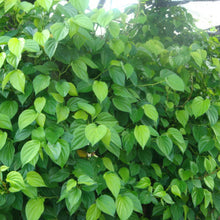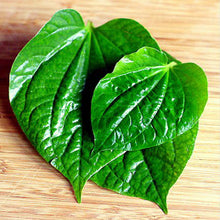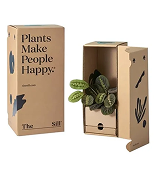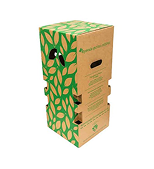- Home
- All In Stock - ExoticFLora
- Maghai Paan/Betel Leaf -...
Maghai Paan/Betel Leaf - Medicinal & Aromatic Plants







Maghai Paan/Betel Leaf - Medicinal & Aromatic Plants

 Climate
Climate Time to yield
Time to yield Growth Pattern
Growth Pattern


Damaged or lifeless? We’ll replace it for free. Learn more




Double layered custom boxes to protect plants during shipping.

Air vents for proper air-flow

To preserve plant freshness during transit

Details steps of how to grow and maintain your plant
Betel leaf (Piper betel) is a creeper grown in India. It belongs to the pepper family. Its waxy green, heart-shaped leaves are used for medicinal and culinary purposes. When crushed, it exudes a cool peppery scent. It’s used in making a famous dessert called ‘Paan’ which is chewed with betel nut as a mouth freshener.
It’s a perennial herb, which can also be grown in containers and hanging baskets. You can grow it from cuttings and root division. It thrives well in a subtropical and tropical climate but growing betel leaf plant in a cold climate (as an annual, mostly) is also possible with extra care, in containers.
Growing - 1st primary stem grow up to 1 m. long, with heart-shaped leaves, after that, it can be either trained as a climber or grown as a ground cover.
Requirement - It prefers slightly acidic, sandy-loamy, and lightly damp soil but not waterlogged. Use the well-drained potting mix to plant it in a way that water will drain out from it quickly. Pick a less windy spot with partial shade for planting. *Choose a medium-sized deep planter, if you’re growing it in the container.
Betel Leaf Care
- It thrives well in a hot and humid environment in partial shade. The betel plant needs regular watering.
- Prune regularly, regular pruning and plucking of leaves encourage new growth and sweet and tender leaves.
- Occasional feeding every couple of months in the growing season of the plant with a nitrogen-rich fertilizer is recommended.
- Keep the plant indoors in winters when the temperature starts to fall below (5C) in a warm and cozy room under grow light.
Pests and Diseases
- It’s not pest-free of course, and attacked by red mites occasionally, which can be treated with insecticidal soap.
- It also suffers from fungal diseases, especially in the rainy season or when overwatering is done. To save the plant, watering should be reduced.
- Leaf blight is another problem that affects the betel plants in which brown and black oily patches cover the leaf. Leaf blight can be treated by simply pulling off the infected leaf or stem.
Harvesting - Within four to six months after planting, it’ll be ready for harvest. You can pick off the fresh aromatic leaves for various uses.
INSIDE THE BOX
| S.No. | PRODUCT NAME | DIMENSION |
| 1. | Paan Plant | 0.5-1 Feet Height |
| 2. | Growing Pot (Black color) | 6 Inch |
*above specifications are for indicative purposess only, actual dimensions may slightly vary.
PLANT CARE
LIGHT CONDITION - Partial Sunlight area or under the Green Shade net.
WATERING SCHEDULE - Water when the topsoil(2-3 inches) feels dry to touch.
SOIL TYPE - The soil should be well-drained, fertile, and rich in organic content.
TEMPERATURE - The average temperature should be 18-30 Degree Celsius.
FERTILIZER APPLICATION - Apply any organic fertilizer once a month. Do not forget to water your plant immediately after the application of fertilizer.
INITIAL CARE FOR 10-15 DAYS JUST AFTER RECEIVING YOUR PLANT
- Remove the Packaging Materials carefully.
- Press the soil in the pot & add additional soil(garden mix) if necessary.
- Maintain moisture in the pot, Do not overwater it may kill your plant, so make sure that the soil should be dry between watering.
- Make sure that plants get enough morning direct bright light(2-3hrs) for 10-15 days & do not go for immediate transplanting (minimum 1 month)
- You can remain the plant in the same pot for 6-7 months, later you can transplant it in a slightly bigger pot than the present.
- Just prune if any branch of the plant is get damaged in transits. New leaves will come definitely.
Selected plant of 8-10 inches
Planted into a 5-inch pot
With healthy, moisture-retaining soil
A care instruction sheet for maintenance guide

Get in touch for best pricing on bulk orders and landscaping projects.
 WhatsApp us
WhatsApp us

Call on 9177805454 (Mon-Sat, 9 AM-6 PM) or WhatsApp us – we’re here to help.
About Exotic Flora
At Exotic Flora, we’re passionate about bridging the gap in bringing plants to everyone. With over 500+ varieties across 7 plant categories, from exotic finds to everyday greens, we bring the entire range to you.
Our plants, sourced from all parts of India are nurtured at Kadiyam, in our 25 acres in-house nursery by a team of expert horticulturists. Once they are ready we ship all our plant varieties across India.
Our services go beyond safe delivery of plants. A dedicated support team is there to help you with any maintenance queries you may have.
At Exotic Flora we always believe in going that extra mile, because everyone should have the plants they love.
Indoor plants it doesn't mean that they don't requires sunlight. they also need 3-4 hours of indirect bright light. The best indirect bright light can be morning or evening sunlight. You can also place your plant near to brightest area of your location.
The soil mix required for most indoor plants are mix of peat moss, vermiculite, perlite, cocopeat, organic compost, sandyloam soil or garden soil. Remeber the soil should be well drained, fertile and rich in organic content.
Remember overwater can kill your plant. Water when the topsoil(2-3 inch) feels dry to touch. In general moderate watering(in every 3-4 days)
There is a details about the individual plant care in the description of each plants. So look at the descrption of selected plants for plant care guidelines.
Chlorophytum comosum, Parlour palm, All Ferns(Green & Golden Boston Fern), Ponytail palm, Areca palm, Pepromia, Table palm. Raphis palm etc.
All Aglaonema, Areca palm, All money plant, All Ficus plant, All Song of India, All Dracaena species, Chlorophytum comosum, All snake plants, Jade green, Crotons etc.
Eventhough they are indoor, they also need minimum 3-4 hours of indirect bright light to produce flowers. Plants like Peace lily, Bird of paradise, Heliconia, Kalanchoe, Anthurium, Chrysanthemum, Poinsettia, Orchid plants etc.
There is a sections in the Indoor plants about the Air-Purifer plants, you can look at that section for more details.
On average, an indoor plant will need repotting every 1-2 years to avoid it from becoming �pot bound� and to allow it to continue to grow and thrive. The best time to repot is during spring to give actively growing roots have enough time to grow into the fresh potting mix.
It is typically due to under watering, overwatering, or too much direct sunlight, try giving it some water and see if it perks up. Sometimes it's as easy as that. Most plants leaves will begin to wilt when they need watered.
It maybe due to when they're exposed to too much fertilizer or too many salts build up in the soil. Always follow the description of fertilizers before using it.
Good packaging and very healthy plant.
Maghai paan is a small in size but healthy plant.
Much too small. Very good packing
Great packaging of paan plant which I ordered
